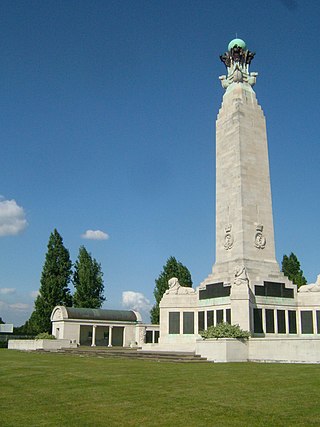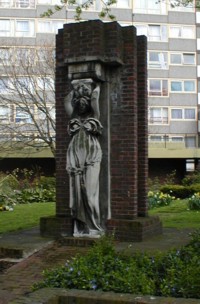
Portsmouth is a port and city in the ceremonial county of Hampshire in southern England. The city of Portsmouth has been a unitary authority since 1 April 1997 and is administered by Portsmouth City Council.

Southsea is a seaside resort and a geographic area of Portsmouth, Portsea Island in England. Southsea is located 1.8 miles (2.8 km) to the south of Portsmouth's inner city-centre. Southsea is not a separate town as all of Portsea Island's settlements were incorporated into the boundaries of Portsmouth in 1904.

The Tower Hill Memorial is a pair of Commonwealth War Graves Commission memorials in Trinity Square Gardens, on Tower Hill in London, England. The memorials, one for the First World War and one for the Second, commemorate civilian, merchant seafarers and fishermen who were killed as a result of enemy action and have no known grave. The first, the Mercantile Marine War Memorial, was designed by Sir Edwin Lutyens and unveiled in 1928; the second, the Merchant Seamen's Memorial, was designed by Sir Edward Maufe and unveiled in 1955. A third memorial, commemorating merchant seamen who were killed in the 1982 Falklands War, was added to the site in 2005.

Rear-Admiral Henry James Raby was a recipient of the Victoria Cross, the highest and most prestigious award for gallantry in the face of the enemy that can be awarded to British and Commonwealth forces.

HMS Royal George was a ship of the line of the Royal Navy. A first-rate with 100 guns on three decks, she was the largest warship in the world at the time of her launch on 18 February 1756. Construction at Woolwich Dockyard had taken ten years.

Chatham Naval Memorial is a large obelisk situated in the town of Chatham, Kent, which is in the Medway Towns. The memorial is a feature of the Great Lines Heritage Park. The huge expanse of the Great Lines was in its own right a layer of defence to protect Chatham Dockyard from attack.

Horatio Nelson, 1st Viscount Nelson (1758–1805) was a British flag officer in the Royal Navy famous for his participation in the Napoleonic Wars, most notably in the Battle of Trafalgar, during which he was killed. He was responsible for several famous victories that helped to secure British control of the seas, both securing Britain from French invasion and frustrating Napoleon's imperial ambitions. After his death during his defeat of the combined French and Spanish fleets at Trafalgar, there was a public outpouring of grief. Nelson was accorded a state funeral and was buried in St Paul's Cathedral.

Henry Poole was a British architectural sculptor.

The Plymouth Naval Memorial is a war memorial in Plymouth, Devon, England which is dedicated to British and Commonwealth sailors who were lost in World War I and World War II with no known grave.

Operation Checkmate was the codename for a raid on shipping at Haugesund, Norway in April 1943 during the Second World War by British Commandos. The raiding party consisted of seven men of No. 14 (Arctic) Commando who managed to sink one ship using limpet mines. While waiting in hiding for the transport back to the United Kingdom they were captured on 14 and 15 May 1943 and eventually taken to Sachsenhausen and Belsen concentration camps where six of them were executed, victims of the Commando Order. The seventh man died of typhus.

The Arras Flying Services Memorial Commonwealth War Graves Commission war memorial in the Faubourg d'Amiens Cemetery, Arras, France. The memorial commemorates nearly 1,000 airmen from forces of the Commonwealth who were killed on the Western Front during World War I and who have no known grave. The memorial was designed by Edwin Lutyens, sculpted by William Reid Dick and unveiled by Hugh Trenchard, 1st Viscount Trenchard, Marshal of the Royal Air Force on 31 July 1932.
James Henry Digby "Bungy" Watson was an English rugby union player. He won 3 caps for England, all in the 1914 Five Nations Championship. He was killed while serving as a surgeon aboard HMS Hawke when it was torpedoed and sunk by U-9 in 1914 during World War I, and is commemorated on the Chatham Naval Memorial.

The Helles Memorial is a Commonwealth War Graves Commission war memorial near Sedd el Bahr, in Turkey, on the headland at the tip of the Gallipoli peninsula overlooking the Dardanelles. It includes an obelisk which is over 30 metres (98 ft) high.

Widnes War Memorial stands in Victoria Park, Widnes, Cheshire, England. It commemorates the serving men who lost their lives in the two world wars. The memorial consists of an obelisk in Portland stone on a plinth of York stone. It was unveiled in 1921, and more names were added in 1950. The monument is recorded in the National Heritage List for England as a designated Grade II listed building.

The Bootle War Memorial is in King's Gardens, Stanley Road, Bootle, Sefton, Merseyside, England. It was paid for partly by a grant from the local council, and partly by public subscription. The sculptor was Herman Cawthra, with assistance in the design from Hubert Ernest Bulmer, the borough's art director. The monument consists of a mother and child on top of an obelisk, which is surrounded by the figures of three servicemen. It was unveiled in 1922, and the names of those killed in the Second World War were added in 1948. The memorial was recorded in the National Heritage List for England as a designated Grade II listed building in 1986, and upgraded to Grade II* in 2018.

The Liverpool Naval Memorial, also known as the Memorial to the Missing of the Naval Auxiliary Personnel of the Second World War or the Merchant Navy War Memorial, is a war memorial at Pier Head beside the River Mersey in Liverpool, near to the Royal Liver Building and the Museum of Liverpool. It commemorates nearly 1,400 men from the British Merchant Navy who died on active service with Royal Navy in the Second World War, and who have no known grave.

The RAMC Memorial at Aldershot in Hampshire is a monument commemorating the men of the Royal Army Medical Corps who lost their lives during the Boer War of 1899 to 1902. It is a Grade II listed structure.

Blackmoor War Memorial is a First World War memorial cloister in Blackmoor, near Liss, in Hampshire. The memorial stands on the north side of the main road, with the Church of St Matthew to the east and the village school to the west. It was designed by Sir Herbert Baker, and comprises a three-sided wood-framed arcade, open to the south, arranged around lawn with a memorial cross. Several memorial plaques and a fountain by Sir Charles Wheeler are mounted on the walls of the arcade. It is one of around 130 Grade II* listed war memorials in England.

Adelaide River War Cemetery is a heritage-listed cemetery at 105 Memorial Terrace, Adelaide River, Northern Territory, Australia. It was added to the Australian Commonwealth Heritage List on 22 June 2004.

The City of Portsmouth War Memorial, also referred to as the Guildhall Square War Memorial, is a First World War memorial in Guildhall Square in the centre of Portsmouth, Hampshire, on the south coast of England. Portsmouth was and remains a port and home to a major naval dockyard. The dockyard and the armed forces provided much of the employment in the area in the early 20th century. As such, the town suffered significant losses in the First World War. Planning for a war memorial began shortly after the end of the conflict and a committee was established for the purpose. It selected a site adjacent to a railway embankment close to the Town Hall and chose the architects James Gibson and Walter Gordon, with sculptural elements by Charles Sargeant Jagger, from an open competition.



















